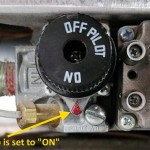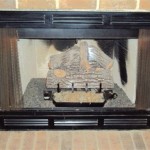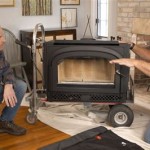Art Deco Fireplace Ideas: A Symphony of Style and Warmth
Art Deco, a design movement that flourished in the 1920s and 1930s, represents a captivating blend of modernism and opulence. Characterized by geometric shapes, streamlined forms, rich materials, and a sense of glamour, Art Deco extended its influence to architecture, furniture, and decorative arts, including fireplace design. An Art Deco fireplace is more than just a source of heat; it is a statement piece, a focal point that embodies the era's sophisticated aesthetic. Integrating Art Deco elements into a fireplace design requires careful consideration of materials, shapes, and ornamentation to achieve an authentic and harmonious look.
This article explores various Art Deco fireplace ideas, delving into the key characteristics of the style and providing inspiration for creating a fireplace that captures the essence of this iconic design movement. From the selection of materials and shapes to the incorporation of decorative details, this guide outlines the essential elements for achieving an Art Deco-inspired fireplace that adds a touch of timeless elegance to any space.
Embracing Geometric Shapes and Streamlined Forms
Geometric shapes are a cornerstone of Art Deco design. Clean lines, symmetrical patterns, and bold geometric motifs are essential elements to consider when designing an Art Deco fireplace. Angular forms, such as chevrons, zigzags, and stepped patterns, were frequently used to create a sense of dynamism and visual interest. Unlike the ornate curves and flowing lines of Art Nouveau, Art Deco favored more structured and precise shapes.
The application of these geometric principles to fireplace design can manifest in several ways. The fireplace surround itself might be constructed from rectangular or square blocks of stone or tile, arranged to create a stepped or tiered effect. The firebox opening can be framed with a geometric border, perhaps featuring a repeating zigzag pattern or a series of concentric squares. Even the fire screen or grate can incorporate geometric designs, further reinforcing the Art Deco aesthetic. Smooth, streamlined forms are another important characteristic. The emphasis is on creating a sense of speed and efficiency, even in a static object like a fireplace. This can be achieved by minimizing superfluous ornamentation and focusing on the essential lines and shapes of the design.
For instance, a fireplace surround constructed from polished black granite, with a simple rectangular shape and subtle stepped detailing, would exemplify this principle. The absence of elaborate carvings or decorative flourishes allows the inherent beauty of the material and the purity of the form to take center stage. Similarly, a mantelpiece with a streamlined, aerodynamic profile, perhaps crafted from chrome or stainless steel, would evoke the era's fascination with technology and progress. The key is to maintain a balance between visual complexity and simplicity, ensuring that the geometric elements are bold and striking without becoming overwhelming or cluttered.
Selecting Luxurious and Contrasting Materials
Material selection is crucial in achieving an authentic Art Deco fireplace. The era was defined by the use of luxurious and high-quality materials, often combined in unexpected and visually striking ways. Common choices included marble, granite, chrome, stainless steel, glass, and exotic woods. The interplay of textures and finishes was also important, with polished surfaces juxtaposed against matte or textured elements to create depth and visual interest.
Marble, with its inherent elegance and luxurious feel, was a popular choice for fireplace surrounds and mantels. White Carrara marble, with its subtle veining, was often used to create a sense of purity and refinement. Black marble, such as Nero Marquina, offered a dramatic contrast and added a touch of sophistication. Granite, another durable and visually appealing stone, was also frequently employed, particularly in darker colors such as black or gray.
Metal played a significant role in Art Deco design. Chrome and stainless steel were used for fireplace accents, such as trim, fire screens, and andirons. These materials added a touch of modernity and reflected the era's fascination with technology. Glass, particularly in the form of mirrored panels or decorative inlays, was also a common element. Mirrored surfaces helped to create a sense of spaciousness and reflected light, enhancing the fireplace's visual impact. Exotic woods, such as ebony, zebrawood, and Macassar ebony, were often used for mantelpieces and decorative panels. These woods added a touch of warmth and richness to the design, contrasting beautifully with the cool, hard surfaces of the stone and metal.
The combination of these materials in a single fireplace design could result in a stunning visual effect. For example, a fireplace surround made of black granite, accented with chrome trim and mirrored inlays, would epitomize the Art Deco aesthetic. The interplay of the dark stone, the reflective metal, and the shimmering glass would create a sense of luxury and glamour. Similarly, a mantelpiece crafted from Macassar ebony, paired with a white Carrara marble surround and a fire screen made of polished stainless steel, would showcase the era's penchant for contrasting materials and textures. The careful selection and combination of materials are essential for creating an Art Deco fireplace that exudes elegance and sophistication.
Incorporating Decorative Motifs and Ornamentation
While Art Deco design generally favored streamlined forms and geometric shapes, it also embraced decorative motifs and ornamentation. These details added visual interest and personality to the fireplace, further enhancing its aesthetic appeal. Common Art Deco motifs included stylized floral patterns, sunbursts, chevrons, zigzags, and geometric abstractions. These motifs were often incorporated into the fireplace design through carvings, inlays, or applied ornamentation.
Stylized floral patterns, typically rendered in a geometric or abstract manner, were a popular choice for adding a touch of nature to the fireplace. These patterns might be carved into the stone surround, inlaid into the wood mantelpiece, or incorporated into the design of the fire screen. Sunbursts, representing rays of light emanating from a central point, were another common motif. These patterns were often used as a focal point, perhaps above the firebox opening or on the mantelpiece. Chevrons and zigzags, with their dynamic and angular forms, were frequently used to create a sense of movement and visual interest. These patterns might be incorporated into the fireplace surround, the fire screen, or the hearth.
Geometric abstractions, representing simplified and stylized versions of natural or man-made objects, were another hallmark of Art Deco design. These abstractions might take the form of repeating patterns, interlocking shapes, or stylized representations of architectural elements. In addition to these motifs, the use of color was also important in Art Deco ornamentation. Bold, contrasting colors, such as black and gold, red and silver, or emerald green and ivory, were often used to accentuate the geometric forms and decorative details. The application of these colors could be achieved through painting, lacquering, or the use of colored stones and glass.
For example, a fireplace surround made of white Carrara marble might be adorned with stylized floral patterns carved into the stone and highlighted with gold leaf. The mantelpiece could feature a sunburst motif inlaid with contrasting colored stones, such as black onyx and lapis lazuli. The fire screen could incorporate a chevron pattern made of polished stainless steel, adding a touch of modernity and dynamism. The careful incorporation of these decorative motifs and ornamentation is essential for creating an Art Deco fireplace that is both visually striking and historically accurate. The key is to strike a balance between ornamentation and simplicity, ensuring that the decorative details enhance the overall design without becoming overwhelming or cluttered.
Lighting also plays a crucial role in accentuating the Art Deco fireplace. Sconces or lamps with geometric designs and metallic finishes can be placed on either side of the fireplace to create a warm and inviting ambiance. The light will reflect off the polished surfaces of the stone, metal, and glass, further enhancing the fireplace's visual impact. Careful attention to lighting can elevate the Art Deco fireplace from a mere functional element to a true work of art.
Furthermore, consider the surrounding décor. Art Deco furniture, such as streamlined sofas and chairs with rich upholstery and geometric detailing, will complement the fireplace and create a cohesive aesthetic. Rugs with geometric patterns and metallic accents can also enhance the overall look. The goal is to create a space that evokes the glamour and sophistication of the Art Deco era, with the fireplace serving as the focal point of the room.
Ultimately, designing an Art Deco fireplace is about capturing the spirit of a bygone era while creating a functional and beautiful element for the modern home. By embracing geometric shapes and streamlined forms, selecting luxurious and contrasting materials, and incorporating decorative motifs and ornamentation, one can create a fireplace that is a true testament to the enduring appeal of Art Deco design. The fireplace will not only provide warmth and comfort but also serve as a stunning centerpiece that reflects the homeowner's appreciation for history, art, and timeless elegance.

Fireplacing In The Home Art Deco Living Room Fireplace Stone Designs

Art Deco Fireplaces In Leeds Classic

Art Deco Fireplace Hearth Natural Stone Traditional Cheshire By Rockford Company Houzz

Art Deco Fireplace Mantel Design Ideas

36 Fireplace Decor Ideas Modern Mantel

Keaton Art Deco Marble Fireplace Twentieth Century Fireplaces Interior Design

50 Fireplace Ideas To Give Your Room That Special Spark

Wyndham Art Deco All Tiled Fireplace Twentieth Century Fireplaces

Art Deco Fireplace Mantel Design Ideas

Contemporary Fireplace Surrounds And Mantels Ideas Direct Fireplaces
Related Posts








